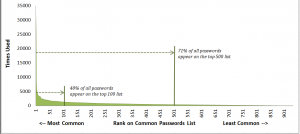
password alternatives
John Klossner, Dark Reading – http://www.darkreading.com/endpoint/authentication/strong-passwords/d/d-id/1127941


password alternatives
John Klossner, Dark Reading – http://www.darkreading.com/endpoint/authentication/strong-passwords/d/d-id/1127941
 “password” has been replaced by the cryptographically clever “123456” according to Splashdata.
“password” has been replaced by the cryptographically clever “123456” according to Splashdata.
Where’s 8675309 when you need it? And Jenny for that matter?
Like word distributions and company sizes, frequency of usage of particular passwords seems to follow a Zipf distribution or power law distribution. That is, there are a lot of people that pick from a small common pool of passwords and that the number of people that use a particular password drops off quickly once you step away from that common pool.
 Mark Burnett’s research shows that, of a list of 10,000 ranked passwords:
Mark Burnett’s research shows that, of a list of 10,000 ranked passwords:
BTW, almost 5% of all users have the password, ‘password’.
List of top passwords here. Heads up — there’s some colorful language in play here for popular passwords.
Why is it important to change default passwords on hardware, applications, and other systems? Because the passwords are published and, in effect, not passwords at all. A few responses from Googling ‘default passwords’ :
And there’s plenty more.
Lesson:
Default password = No password
Poor password policies and management can be an Achilles heal for any business. Making it more challenging for small and medium sized businesses is that they often cannot afford to implement or support full Identify Access Management systems. There is, however, some middle ground.